|
The Virus in the Environment / Disinfection

At some point after a household has dealt with a parvo infected puppy, the question of introducing a new puppy will eventually come up. How is the environment to be disinfected so that a new puppy can be safely introduced? How much time should pass? The fact is that safe puppy introduction is tricky so let's review what we know.
|
THE VIRUS ITSELF
The canine parvovirus is extremely hardy in the environment. Some viruses (like SARS-Cov2 and canine distemper) are enveloped in a delicate fat membrane such that the simple act of washing with soap will destroy their structure. Not so with the parvovirus family. Parvoviruses are tough, happy to overwinter in freezing temperatures, readily carried on shoes and clothing to new areas, and resistant to numerous cleaning agents. Making matters worse, an infected puppy will shed very large numbers of virus during its illness making for large numbers of virus, plenty to infect a new puppy, all over the place.
|
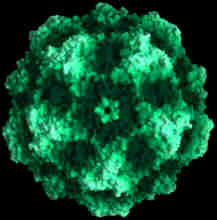
This is the actual canine parvovirus
(image by JY Sgro, UW-Madison)
|
|
|
A typical/average infectious dose for an unvaccinated dog is 1000 viral particles. For some dogs far less is needed.
For other dogs, far more is needed. An infected dog sheds 35 million viral particles
(35,000 TIMES the typical infectious dose) per OUNCE of stool.
|
|
|
So here we have a heavily contaminated home, possibly both indoors and outdoors. How do we go about making it safe for a new puppy or is that even possible? The short answer, is that the parvovirus is considered ubiquitous (present everywhere!) even when there hasn't been an infected dog in the house, so total safety is not possible but there is a lot we can do to improve the odds.
|
BLEACH (AND OTHER DISINFECTANTS)
Parvoviruses are not completely invulnerable. Happily, there is an inexpensive extremely effective disinfectant that is available to virtually every household: bleach. It turns out that a half cup of bleach mixed in a gallon of water creates a 1:30 dilution that effectively kills parvovirus as long as 10 minutes of contact time are allowed. Obviously, bleach can discolor fabric and can also kill shrubs and plants, so it is not for every surface but it is a valuable tool in your disinfection project.
Accelerated hydrogen peroxide (not the same as the regular hydrogen peroxide that you may already have in your bathroom) is also effective. Again, these products are likely to discolor fabrics and a 10 minute contact time is required. This can be another tool for the disinfection project.
Area rugs can simply be thrown away. Large areas of carpet will be a problem. Any remnant waste should be scrubbed away and steam cleaning may be helpful as the parvovirus does not do well in hot temperatures. If the environment cannot be decontaminated, consider a vaccinated older pup for adoption.
|
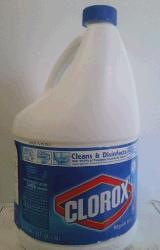
(original graphic by marvistavet.com)
|
|
THE SURVIVING DOG
The parvo survivor only sheds virus for a limited time period and this period is usually over with by the time the puppy has recovered and gone home. That said, earlier in the infection this same puppy was shedding spectacular amounts of virus and this virus is still in the recovered puppy's fur. A good bath should wash it off. Make sure any fecal material caked on the feet or anywhere else on the body has been removed. Waiting a few weeks for the coat to turnover somewhat may be prudent. We don't want virus to persist on the recovered dog any more than we want it persisting on bowls, toys or bedding.
BOWLS, TOYS AND BEDDING
The simplest solution here is to just throw them out and get new ones but that is probably not necessary if bleaching is possible. As noted, a 10 minute soaking time is needed and the bleach needs to be fully removed before contact with the new puppy. Use your judgment as to how effectively this can be accomplished and it is crucial that any fecal matter or vomit from the infected puppy be completely gone with no remaining stains before the object can be considered safe again.
|
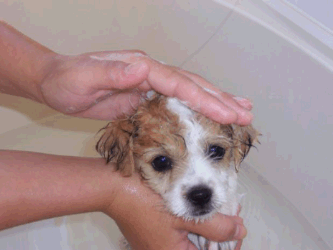
(Photocredit: Morguefile.com) |
IF AN ITEM AN GO THROUGH THE WASHING MACHINE WITH BLEACH, IT SHOULD BE SAFE AFTERWARDS.
|
DECONTAMINATION OF THE OUTDOORS
DIRT, GRASS, GRAVEL
The virus is protected by the fecal matter around it. This means removing as much visible fecal material as possible is important. If the area involves dirt, using a shovel to remove the fecal material plus any soil around it is helpful. Grass and gravel are a little trickier but the more virus can be removed and discarded, the better. After removing the contaminated soil, hose the area down to help dilute and rinse away any remaining virus.
CONCRETE, WOOD, STONE
These surfaces can be cleaned with bleach or accelerated hydrogen peroxide as described above. Be sure all gross fecal matter has been scrubbed away.
|
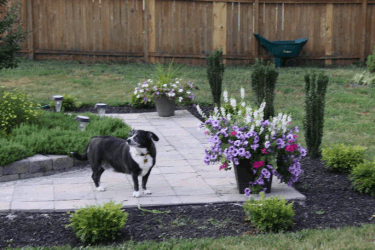 (Photocredit: Morguefile.com) (Photocredit: Morguefile.com) |
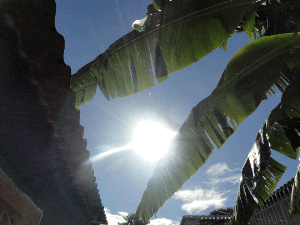 (Photocredit: Morguefile.com) (Photocredit: Morguefile.com) |
THE SUN IS YOUR FRIEND.
DEHYDRATION OF ORGANIC MATTER HARBORING THE VIRUS WILL READILY INACTIVATE THE VIRUS.
AREAS WITH FULL SUN, WILL REQUIRE LESS DECONTAMINATION.
FULL SHADE AND MOISTURE ARE PROTECTIVE TO THE VIRUS.
FOCUS YOUR EFFORTS ON THESE AREAS.
|
|
FREEZING IN THE WINTER
Unfortunately, the virus over-winters pretty well. It remains dormant when frozen and remains infective. Further, shoveling away contaminated soil is not going to be easy if the ground is frozen. The virus an live for 5 months and possibly more if the ground is frozen. If the frozen ground defrosts in the spring but remains shaded, complete disinfection may not be possible.
Snow is a mixed blessing. Snow will hide the fecal matter that one needs to remove but, on the other hand, when the snow melts into water, it can dilute the virus and help it wash away.
CONSIDER THE FROZEN YARD TO BE CONTAMINATED
UNTIL SPRING WHEN DISINFECTION CAN RESUME.
|
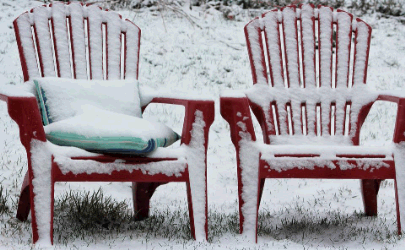
(Photocredit: Morguefile.com) |
DECONTAMINATION OF THE INDOORS
Indoors, we have carpeting and special surfaces to contend with but the same principles apply. First, any traces of fecal matter must be removed. Surfaces should be scrubbed clean and it may be simplest to throw away items that are easily replaced. Bleach areas as described above where ever surfaces can tolerate bleach (tile, vinyl flooring etc.) Carpeting, rugs, and upholstery are likely not going to tolerate bleach without color damage so another strategy is needed.
CARPET, RUGS, AND UPHOLSTERY
As mentioned, proper disinfection will damage colored fabrics. Steam cleaning theoretically will kill the virus but most services simply use hot water vapor that are not adequately heated and does not penetrate adequately. If possible, area rugs should be thrown out. Gross contamination should be scrubbed away but if the item or area cannot be bleached, consider a vaccinated older puppy or adult dog as the next resident.
|
THE NEW PUPPY
Review that the puppy's immunity is coming from either his or her mother or from vaccination. Younger puppies probably have not completed their vaccination series. Adoption is stressful as is shipping/transport and stress will hamper a strong immune response. This means that the smartest strategy after a home environment has been parvo contaminated, is to adopt an immune puppy. This means an older puppy (16 weeks at the youngest) and one that has been fully vaccinated with at least 2 sets of parvo vaccination, the last dose being received at approximately 16 weeks of age.
ADOPTING AN INCOMPLETELY VACCINATED PUPPY POSES AN ELEMENT OF INFECTION RISK.
|
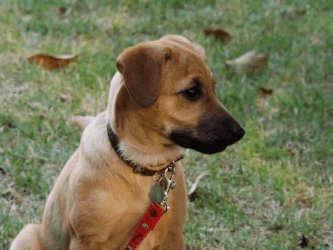
(Photocredit: Morguefile.com) |
A PROPER PUPPY VACCINATION SERIES INVOLVES AT LEAST 2 PARVO VACCINES
WITH THE LAST ONE OCCURRING AT AGE 16 WEEKS OR OLDER.
A PUPPY WITH THIS HISTORY SHOULD HAVE ADEQUATE IMMUNITY.

Page last updated: 9/27/2025
|